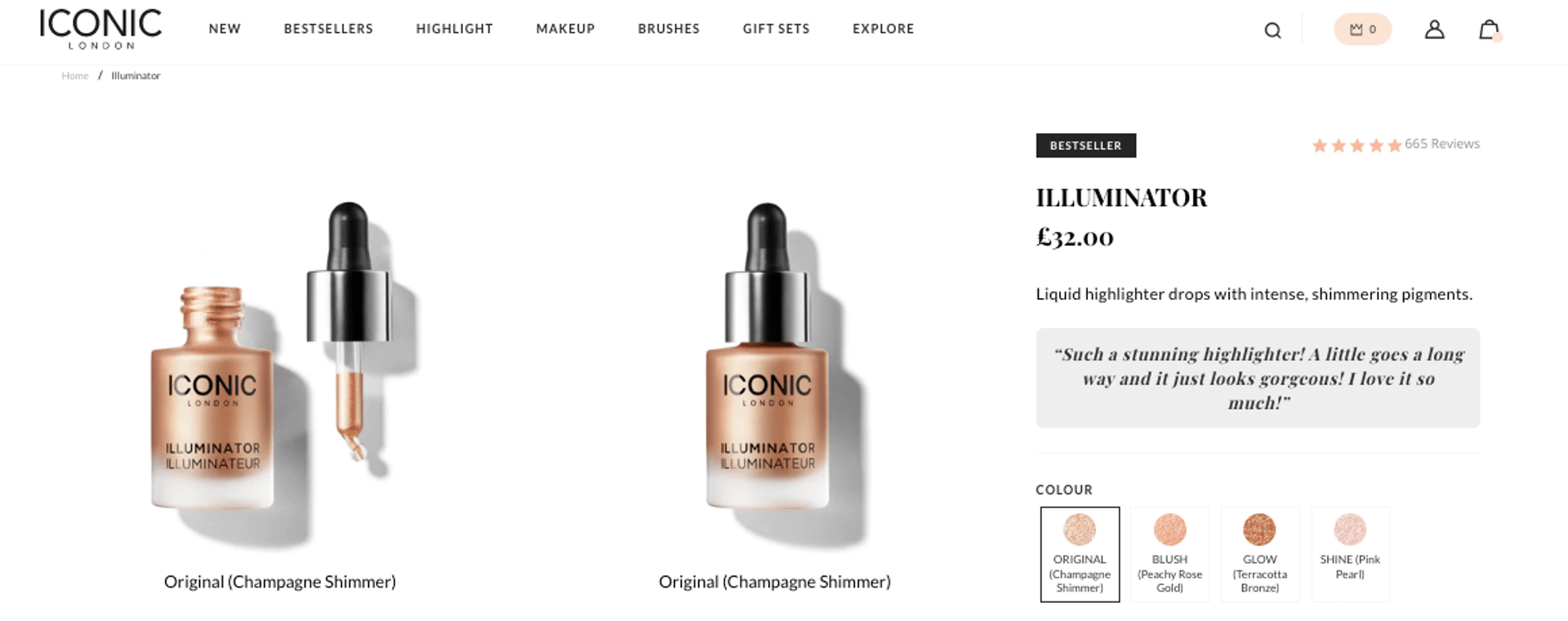Iconic London connaît parfaitement les habitudes et les préférences de ses consommateurs. La société s’est toujours fiée aux réseaux sociaux et aux CGU (avis, photos, vidéos, et autres contenus créés par les consommateurs) pour développer sa marque et communiquer avec ses adeptes. Bien qu’Iconic London recevait un nombre important de CGU, la société recherchait un moyen efficace de publier tous ces contenus au sein de ses canaux numériques afin d’améliorer sa relation avec les clients et de renforcer sa croissance économique.
« Nous sommes doués pour sensibiliser le public et faire retentir la voix de la marque, sans jamais perdre de vue que nous évoluons dans un secteur concurrentiel où évoluent beaucoup de marques expertes en matière de communication, commercialisant d’excellents produits. Il nous fallait trouver un moyen d’exploiter le volet social en notre faveur, à la fois en termes marketing et financiers, et c’est justement là où Bazaarvoice s’est avéré des plus utiles », exprime Eleanor Assa, CMO chez Iconic London.
En partenariat avec Bazaarvoice, Iconic London a lancé Like2Buy sur Instagram et a installé Bazaarvoice Galleries sur ses pages produits et sa page d’accueil. Cette initiative a permis de rationaliser la continuité entre ses canaux numériques et de booster ses métriques d’e-commerce.
Les contenus générés par les utilisateurs stimulent l’engagement numérique
Les CGU sont souvent la force motrice qui sous-tend les secteurs axés sur le concept de communauté, notamment la santé et la beauté. Les avis sur le maquillage, les astuces beauté, et les guides sur les soins de la peau sont les fondements des réseaux sociaux, et lorsque les marques favorisent les CGU, l’engagement augmente naturellement. Après tout, qui ne souhaite pas voir sa publication Instagram apparaître sur le site Web d’une marque ?


« Nous sommes une marque niche dont le cœur de métier repose sur le modèle suivant : les consommateurs essayent nos formules, les adorent puis partagent leur point de vue en ligne. Nous pouvons utiliser ce mode de communication pour développer notre marque et sensibiliser davantage le marché dans cet environnement des plus concurrentiels », déclare Eleanor Assa.
Cet esprit communautaire basé sur le partage et la consommation de CGU dans l’industrie de la beauté aide les marques à exploiter l’économie du créateur (qui s’ouvre depuis peu aux petits créateurs). Iconic London a utilisé des insights, comme des tags sur les photos issus de la collecte de CGU, pour identifier des opportunités de partenariats avec de nouveaux créateurs, dans une dynamique de partage accru de contenus authentiques. « Ainsi, nous pouvons identifier les nano-influenceurs et les adeptes de la marque avec lesquels nous voudrions collaborer davantage… c’est prometteur », explique Eleanor Assa.
Mais les consommateurs ne créent pas que des CGU. Ils créent de l’engagement sur les pages produits, les pages d’accueil et les réseaux sociaux. « Grâce aux CGU, les consommateurs peuvent interagir avec les contenus, ils peuvent donc faire autant de recherches qu’ils souhaitent, que ce soit sur notre marque ou sur nos produits. Nous leur offrons différentes manières d’interagir avec nous et je pense que c’est la partie la plus intéressante pour nous », souligne Eleanor Assa.
Bazaarvoice Galleries stimule les métriques d’e-commerce
Bazaarvoice Galleries permet aux marques de personnaliser leurs pages produits et leurs pages d’accueil avec des CGU visuels issus des réseaux sociaux. Cette stratégie favorise la continuité entre les canaux et crée une expérience d’achat ininterrompue. Cela apporte une certaine authenticité à un canal qui est habituellement plus orienté marques, et c’est exactement ce que souhaitent les consommateurs.


« En intégrant Bazaarvoice et la pièce du puzzle que sont les CGU, nous sommes en mesure d’ajouter de l’authenticité à notre formule », précise Eleanor Assa. L’authenticité dynamise les ventes. Lorsqu’Iconic London a ajouté Bazaarvoice Galleries sur sa page d’accueil et sur ses pages produits, son taux de conversion a augmenté de 126 % et la valeur du panier moyen a augmenté de 11 % sur 12 mois. Les consommateurs passent également plus de temps à consulter les CGU et les pages produits, d’où une augmentation de 361 % de temps passé sur le site.
« Le temps passé sur le site est une donnée vraiment fascinante pour nous. Nous sommes ravis de cette augmentation car, selon moi, cela prouve que nos suppositions quant à nos consommateurs étaient justes : ils aiment parcourir les sites, ils aiment regarder les gens qui leur ressemblent un peu. En parallèle, ils regardent des images et des pages produits différentes. C’est essentiel pour nous que les consommateurs passent plus de temps sur le site », déclare Lizzie Newell, responsable du service Marketing, Social, and Campaigns chez Iconic London.
Publier des CGU en boutique permet également à Iconic London de montrer à leurs consommateurs tout l’amour qu’ils ont pour eux. « Les galeries des pages produits ont un succès fou, nous sommes absolument aux anges. Nous faisons enfin bon usage des centaines de tags que nous recevons chaque jour, c’est super. Et ça permet aussi à nos consommateurs de se retrouver aussi sous le feu des projecteurs, ce qui est vraiment sympa pour eux », affirme Lizzie Newell.
Like2Buy renforce les expériences Web et sociales
Like2Buy transforme les contenus sociaux en une expérience d’achat avec des liens accessibles vers les pages produits, créant ainsi une expérience conviviale pour les consommateurs. Le Social commerce devrait connaître une croissance importante au cours des années à venir, et Iconic London a rapidement adopté ces mutations, puisque la marque a toujours fait du social sa priorité.
« Nous savons que nos clients aiment faire leurs achats dans un environnement social. C’est la tendance du secteur, mais surtout d’Iconic. Donc Like2Buy nous permet de poursuivre cette expérience d’achat sociale un peu plus longtemps. Cette fonctionnalité nous permet de déborder sur le site Web, sur la page produit et sur la page d’accueil », déclare Lizzie Newell.

Le déploiement de Like2Buy sur Instagram a été une solution efficace pour aider Iconic London à augmenter son chiffre d’affaires, alors que la mise à jour iOS par Apple entraînait des pertes dans plusieurs secteurs. « Like2Buy a été une solution incroyable pour nous. Nous l’avons installée à un moment où nos revenus issus d’Instagram diminuaient légèrement à cause de l’évolution du paysage numérique. Elle a plus que compensé cette baisse : elle nous a remis sur pied et c’était incroyable à voir », atteste Lizzie Newell.

Renforcez la confiance, faites preuve d’authenticité et interagissez avec les consommateurs grâce aux contenus générés par les utilisateurs
Renforcer la confiance grâce à l’authenticité, la continuité et les interactions est une problématique au cœur de la stratégie numérique d’Iconic London. En mettant l’accent sur les CGU, Iconic London souhaite élargir son public afin de publier une plus vaste gamme de passionnés de beauté sur ses canaux numériques.
« Nous souhaitons continuer à nous développer dans notre pays d’origine mais également nous tourner vers l’extérieur et nous assurer que nos contenus plaisent sur tous les marchés dans lesquels nous évoluons. Les CGU nous sont d’une aide précieuse à cet égard. On voit tellement de personnes de nombreux pays différents. La représentation devient beaucoup plus fidèle au consommateur, et c’est incroyable pour nous en tant que marque de surfer sur cette vague d’inclusion », indique Eleanor Assa.
Découvrez comment encourager les consommateurs à passer plus de temps sur le site, stimuler le taux de conversion, et augmenter la valeur du panier. Demandez une démonstration.






